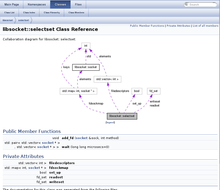 | |
| Developer(s) | Dimitri van Heesch |
|---|---|
| Initial release | 26 October 1997; 27 years ago (1997-10-26) |
| Stable release | 1.13.2 |
| Repository | |
| Written in | C++ |
| Operating system | Cross-platform |
| Type | Documentation generator |
| License | GPLv2 |
| Website | doxygen.nl |
Doxygen (/ˈdɒksidʒən/ DOK-see-jən) is a documentation generator that works with many programming languages. It extracts information from specially-formatted source code comments and saves the information in one of various supported formats.
Doxygen supports static analysis of a codebase. It uses the parse tree parsed from the codebase to generate diagrams and charts of the code structure. It provides cross-referencing that a reader can use to refer back to the source code from the generated documentation.
Doxygen can be used in many programming contexts. It supports many languages including C, C++, C#, D, Fortran, IDL, Java, Objective-C, Perl, PHP, Python, and VHDL. It can run on many computers, including Unix-like, macOS, and Windows systems. It is free software, released under the terms of the GNU General Public License version 2 (GPLv2).
History
The first version of Doxygen borrowed code from an early version of DOC++, developed by Roland Wunderling and Malte Zöckler at Zuse Institute Berlin. Later, the Doxygen code was rewritten by Dimitri van Heesch.
Development
The Doxygen source code is hosted at GitHub, where the main developer, Dimitri van Heesch, contributes under the name "doxygen". Doxygen is written in C++, and consists of around 300,000 source lines of code. For lexical analysis, Lex (or its replacement Flex) is run via approximately 35,000 lines of lex script. The parsing tool Yacc (or its replacement Bison) is also used, but only for minor tasks. The bulk of parsing is done via native C++ code. The build system includes CMake and Python script.
Design
Like other documentation generators such as Javadoc, Doxygen extracts information from both the comment and the symbolic (non-comment) code. A comment is associated with a programming symbol by immediately preceding it in the code. Markup in the comments allows for controlling inclusion and formatting of the resulting documentation.
Doxygen supports output in many formats including: HTML, CHM, RTF, PDF, LaTeX, PostScript and man page.
Doxygen can generate inheritance diagrams for C++ classes. For more advanced diagrams and graphs, Doxygen can use the "dot" tool from Graphviz.
Example
All examples are given for languages with C-like comments where a multi-line comment starts with /* and a single line comment starts with //.
Doxygen ignores a comment unless it is marked specially. For a multi-line comment, the comment must start with /** or /*!. A markup tag is prefixed with a backslash (\) or an at-sign (@). The following is a relatively simple function comment block with markup in bold:
/**
Function description
@param p1 Parameter description
@param p2 Parameter description
@return Return description
*/
void foo(int p1, int p2) {}
A block can be formatted various ways. A common way is to left-align asterisks on each line which Doxygen does not include in the output. For example:
/**
* Function description
* @param p1 Parameter description
* @param p2 Parameter description
* @return Return description
*/
void foo(int p1, int p2) {}
Alternatively, a block can consist of a series of single-line comments. Doxygen accepts comments with an additional slash (/) or exclamation (!).
/// Function description
/// @param p1 Parameter description
/// @param p2 Parameter description
/// @return Return description
void foo(int p1, int p2) {}
To locate a documentation comment to the right of the code, an additional < marker is required. This allows for an alternative approach for documenting parameters as shown below.
/**
* Function description
*/
void foo(int p1 /**<Parameter description*/, int p2 /**<Parameter description*/) {}
A mathematic formula can be specified via LaTeX commands. For example:
/**
* An inline equation @f$ e^{\pi i}+1 = 0 @f$
* A displayed equation: @f
*/
A more complete example in C++:
/**
* @file
* @brief Time class header
* @author John Doe <jdoe@example.com>
* @version 1.0
* @copyright CC BY-SA or GFDL
* @sa <a href="https://en.wikipedia.org/Wikipedia:Copyrights">Misplaced Pages:Copyrights - Misplaced Pages</a>
*/
/**
* Represents a moment of time
* @author John Doe
*/
class Time {
public:
/**
* Construct with a duration since Jan 1, 1970
* @param millis A number of milliseconds
*/
explicit Time(long millis) : m_millis(millis) {
}
/**
* Get a new instance with the current time
* @return Instance
*/
static Time now() {
// ...
}
private:
long m_millis; ///< Milliseconds since Jan 1, 1970
};
See also
References
- ANNOUNCE: doxygen 0.1 Archived October 4, 2011, at the Wayback Machine, Announcing: the first release of Doxygen, a C++ documentation system. , From: Dimitri van Heesch, Date: Sun, 26 Oct 1997, Qt-interest Archive
- "Doxygen release 1.13.2". 9 January 2025. Retrieved 9 January 2025.
- "Doxygen Manual: Frequently Asked Questions". www.doxygen.nl.
- Perkel, Jeffrey M. (2015-11-22). "Get With the Program: DIY tips for adding coding to your analysis arsenal". The Scientist (Journal). The Scientist.
- Sabin, Mihaela (2015-11-22). "Doxygen". OpenComputing (Wiki). University of New Hampshire. Archived from the original on 2015-11-23.
- "Doxygen". Free Software Directory (Wiki). 2015-11-22.
- "Documentation". Rosetta Code (Wiki). 2015-11-22.
- "Documentation: C". Rosetta Code (Wiki). 2015-11-22.
- "Documentation: Objective-C". Rosetta Code (Wiki). 2015-11-22.
- "Doxygen::Filter::Perl - A perl code pre-filter for Doxygen - metacpan.org". metacpan.org.
- ^ "Doxygen Manual: Getting started". www.doxygen.nl.
- "Automatic Python API documentation generation tools". python.org wiki (Wiki). 2015-11-22.
- Brown, Eric W. "doxypypy: A Doxygen filter for Python" – via PyPI.
- "doxygen/doxygen". June 9, 2021 – via GitHub.
- "Doxygen Manual: Graphs and diagrams". www.doxygen.nl.
- Doxygen: Special Commands
- Doxygen: Documenting the code - §Comment blocks for C-like languages
- Doxygen: Documenting the code - §Putting documentation after members